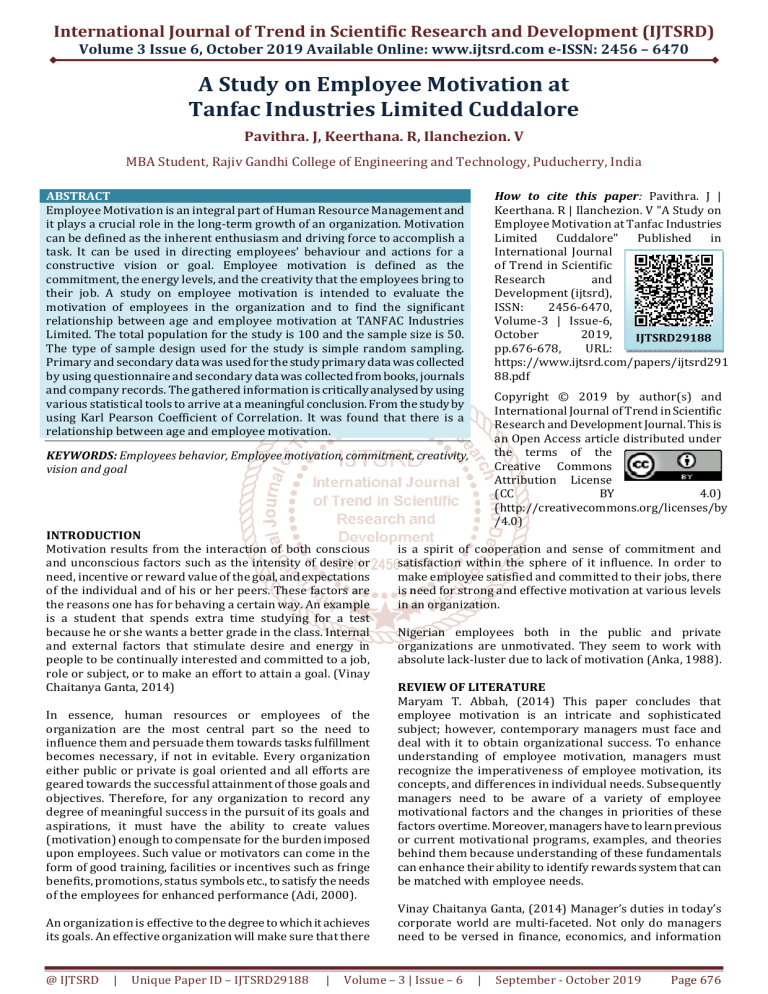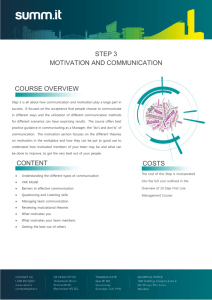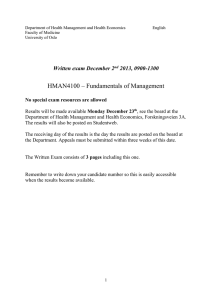
International Journal of Trend in Scientific Research and Development (IJTSRD) Volume 3 Issue 6, October 2019 Available Online: www.ijtsrd.com e-ISSN: 2456 – 6470 A Study on Employee Motivation at Tanfac Industries Limited Cuddalore Pavithra. J, Keerthana. R, Ilanchezion. V MBA Student, Rajiv Gandhi College of Engineering and Technology, Puducherry, India ABSTRACT Employee Motivation is an integral part of Human Resource Management and it plays a crucial role in the long-term growth of an organization. Motivation can be defined as the inherent enthusiasm and driving force to accomplish a task. It can be used in directing employees’ behaviour and actions for a constructive vision or goal. Employee motivation is defined as the commitment, the energy levels, and the creativity that the employees bring to their job. A study on employee motivation is intended to evaluate the motivation of employees in the organization and to find the significant relationship between age and employee motivation at TANFAC Industries Limited. The total population for the study is 100 and the sample size is 50. The type of sample design used for the study is simple random sampling. Primary and secondary data was used for the study primary data was collected by using questionnaire and secondary data was collected from books, journals and company records. The gathered information is critically analysed by using various statistical tools to arrive at a meaningful conclusion. From the study by using Karl Pearson Coefficient of Correlation. It was found that there is a relationship between age and employee motivation. How to cite this paper: Pavithra. J | Keerthana. R | Ilanchezion. V "A Study on Employee Motivation at Tanfac Industries Limited Cuddalore" Published in International Journal of Trend in Scientific Research and Development (ijtsrd), ISSN: 2456-6470, Volume-3 | Issue-6, October 2019, IJTSRD29188 pp.676-678, URL: https://www.ijtsrd.com/papers/ijtsrd291 88.pdf Copyright © 2019 by author(s) and International Journal of Trend in Scientific Research and Development Journal. This is an Open Access article distributed under the terms of the Creative Commons Attribution License (CC BY 4.0) (http://creativecommons.org/licenses/by /4.0) KEYWORDS: Employees behavior, Employee motivation, commitment, creativity, vision and goal INTRODUCTION Motivation results from the interaction of both conscious and unconscious factors such as the intensity of desire or need, incentive or reward value of the goal, and expectations of the individual and of his or her peers. These factors are the reasons one has for behaving a certain way. An example is a student that spends extra time studying for a test because he or she wants a better grade in the class. Internal and external factors that stimulate desire and energy in people to be continually interested and committed to a job, role or subject, or to make an effort to attain a goal. (Vinay Chaitanya Ganta, 2014) In essence, human resources or employees of the organization are the most central part so the need to influence them and persuade them towards tasks fulfillment becomes necessary, if not in evitable. Every organization either public or private is goal oriented and all efforts are geared towards the successful attainment of those goals and objectives. Therefore, for any organization to record any degree of meaningful success in the pursuit of its goals and aspirations, it must have the ability to create values (motivation) enough to compensate for the burden imposed upon employees. Such value or motivators can come in the form of good training, facilities or incentives such as fringe benefits, promotions, status symbols etc., to satisfy the needs of the employees for enhanced performance (Adi, 2000). An organization is effective to the degree to which it achieves its goals. An effective organization will make sure that there @ IJTSRD | Unique Paper ID – IJTSRD29188 | is a spirit of cooperation and sense of commitment and satisfaction within the sphere of it influence. In order to make employee satisfied and committed to their jobs, there is need for strong and effective motivation at various levels in an organization. Nigerian employees both in the public and private organizations are unmotivated. They seem to work with absolute lack-luster due to lack of motivation (Anka, 1988). REVIEW OF LITERATURE Maryam T. Abbah, (2014) This paper concludes that employee motivation is an intricate and sophisticated subject; however, contemporary managers must face and deal with it to obtain organizational success. To enhance understanding of employee motivation, managers must recognize the imperativeness of employee motivation, its concepts, and differences in individual needs. Subsequently managers need to be aware of a variety of employee motivational factors and the changes in priorities of these factors overtime. Moreover, managers have to learn previous or current motivational programs, examples, and theories behind them because understanding of these fundamentals can enhance their ability to identify rewards system that can be matched with employee needs. Vinay Chaitanya Ganta, (2014) Manager’s duties in today’s corporate world are multi-faceted. Not only do managers need to be versed in finance, economics, and information Volume – 3 | Issue – 6 | September - October 2019 Page 676 International Journal of Trend in Scientific Research and Development (IJTSRD) @ www.ijtsrd.com eISSN: 2456-6470 systems; it is now essential for them to have a firm grasp on organizational behavior and psychology. They must know how their people think and what makes them do so. Making sure managers are aware of this psychology is the job of the human resource department, but all managers of the organization have a responsibility to understand it. A key aspect of organizational psychology is motivation. Managers must know why their people behave the way they do, so that these buttons can be pushed at the manager’s discretion. A motivator is that which impels or compels an individual to act toward meeting a need. Some major motivational theories will also be explored. Practical ways of applying these theories to real people will be considered. Elizabeth Boye Kuranchie-Mensah (2015) The study showed that employees of the four large scale mining companies are motivated by both intrinsic and extrinsic factors with particular emphasis on pay or remuneration. Good pay was identified to be the best motivating factor for employees at the mining industry. According to Frey (1997), once pay exceeds subsistence level, intrinsic factors are stronger motivators, and staff motivation requires intrinsic rewards such as satisfaction at doing a good job and a sense of doing something worthwhile. From the study, the intrinsic factors showed a strong significant difference on the motivation which suggests that, once workers are paid very well, they will appreciate the intrinsic factors. Osabiya, Babatunde Joseph (2015) All motivated workers are pampered in their effort to perform creditably well in their functions. The needs and wants of the employees should be looked into. The employees should be exposed to seminars and workshops as they play significant role in reviewing the past with criticisms and providing solutions and remedies to current problems and issues in the best interest of the employees and the organization itself. The use of periodic performance reviews, basing recognition upon systematic evaluation would also help motivate workers. Hashim ZAMEER (2014) Motivational theories such as Maslow’s hierarchy of need, Herzberg’s Two-Factor Theory and Alderfer’s three party hierarchies of needs. We follow two theories of needs Maslow’s hierarchy of need and Alderfer’s three party hierarchies of needs. These researchers gave their point of view related to human needs and human needs play an important role to motivate the employees of any organization. Anyim (2012) and Chintalloo & Mahadeo (2013) also follow these theories of need. These theories helps us how to motivate the employee. According to Maslow hierarchy of need if organization fulfills basic need, safety need, belonging need, self-esteem need and self-actualization of their employees then the performance of employee easily increases. And according to Alderfer’s three party hierarchy of needs if organization fulfill the existence need, relatedness needs and growth needs the performance of employees are also increase. OBJECTIVE OF STUDY 1. To determine various factors influencing employee motivation at Tanfac Industries limited Cuddalore. 2. To find the significant relationship between age of the employees and employee motivation. 3. To find the significant association between gender of the employees and employee motivation. HYPOTHESIS OF THE STUDY 1. Ho: There is no significant relationship between age and employee motivation. 2. Ha: There is a significant relationship between age and employee motivation 3. H0: There is no significant association between gender of the employee and employee motivation. 4. Ha: There is a significant association between gender of the employee and employee motivation RESEARCH METHODOLOGY Research methodology is the scientific way to solve the research problem. This involves exploring all possible methods of solving the research problem; examine the alternative methods one by one and arriving at the best possible method considering the resources at the disposal of the researcher. 1. DATA TYPES: In this study primary and secondary data is used. Primary data is a data which is collected fresh at first time by the researcher himself viva collecting questionnaire, observation method, telephone interview method and personal interview method. Secondary data is a data which is collected by someone else already like books, journals, articles etc. 2. SAMPLING METHOD: In this study stratified random sampling method is used. In this method the population is divided into various subpopulations. In the survey the population is varies then the subpopulation then we select items from each stratum to constitute a sample. 3. TYPE OF RESEARCH: The descriptive research is used in this study. The main characteristic of descriptive research as no control over the research variables, and without covering why it is occurs 4. POPULATION: The population is defined as a group of event or things of interest that the researcher wishes to investigate. In this study the population is finite and the sample N=100 and the sample size n=50. 5. STATISTICAL TOOLS: To make an effective recharge the following tools are used: Percentage method. Correlation. Chi square. DATA INTERPRETATION Table 1 shows age of the employee and employee motivation Sample size Factor 1 Factor 2 Calculated value Interpretation 50 Age of the employee Employee motivation 0.5 Low degree of positive correlation Source: primary data @ IJTSRD | Unique Paper ID – IJTSRD29188 | Volume – 3 | Issue – 6 | September - October 2019 Page 677 International Journal of Trend in Scientific Research and Development (IJTSRD) @ www.ijtsrd.com eISSN: 2456-6470 Inference: The value of correlation r=0.5. This shows that there exists a positive correlation between age and employee motivation. Hence we reject the null hypothesis and accept the alternative hypothesis. It was found that there is a relationship between age and employee motivation Table 2: The chi-square table shows the association between gender of the employee motivation Employee motivation Gender of the employee Low Moderate High Total Low 16 21 0 37 Moderate 1 12 0 13 High 0 0 0 0 Total 17 33 0 50 Source: primary data Inference: From the above calculation it is found that the chi square value is 5.418 and the p value is 0.2470 which is lesser than 0.05. Therefore H0 is accepted and concluded that there is no association between gender of the employee and employee motivation FINDINGS The findings of the study are 1. The Tanfac Industries Limited has a well-defined organization structure. 2. The employees are really motivated by the management. The employees are satisfied with the present incentive plan of the company. 3. The study reveals that there is a good relationship exists among employees. Majority of the employees agreed that there job security to their present job. 4. The company is providing good safety measures for ensuring the employees safety. 5. From the study it is clear that most of employees agrees to the fact that performance appraisal activities and support from the co-workers in helpful to get motivated. 6. The study reveals that increase in the salary will motivates the employees more. 7. The incentives and other benefits will influence the performance of the employees. 8. It was found that by using Chi-Square test P-value is 0.2470 which was lesser than 0.05 and there is a significant association between gender of the employee and employee motivation. SUGGESTIONS The suggestions for the findings from the study are follows 1. Most of the employees agree that the performance appraisal activities are helpful to get motivated, so the company should try to improve performance appraisal system ,so that they can improve their performance. 2. Organization should give importance to communication between employees and gain co-ordination through it. 3. Skills of the employees should be appreciated. 4. Better carrier development opportunities should be given to the employees for their improvement. 5. If the centralized system of management is changed to a decentralized one, then there would be active and committed participation of staff for the success of the organisation. @ IJTSRD | Unique Paper ID – IJTSRD29188 | CONCLUSION The study concludes that the motivational program and procedure in TANFAC INDUSTRIES LTD is found effective but not highly effective. The study on employee motivation highlighted many factors which will help to motivate the employee. The study was concluded among 60 employees and collected information through structured questionnaire. The study helped to findings which were related with employee motivational programs which are provided in the organization. The performance appraisal activities really play a major role in motivating the employees of the organisation . It is a major factor that makes an employee feels good in his work and results in his satisfaction too. The organization can still concentrate on specific arears which are evolved from this study in order to make the motivational programs more effective. Only if the employees are properly motivated they work well and only if they work well the organization is going to benefit out it. Steps should be taken to improve the motivational programs procedure in the future. REFERENCE: [1] Adi, D. Y. (2000). Motivation as a Means of Effective Staff Productivity in the Public Sector: A case study of Nigeria Immigration Service, Borno State of Nigeria. Unpublished MPA Thesis. School University of Maiduguri, Nigeria. [2] Anka, L. M. A., & Anka, M. (1988). Corporate Objectives and Self Development: The Specialist International. Journal of Institute of Management Specialist, 3(5). [3] Ganta, V. C. (2014). Motivation in the workplace to improve the employee performance. International Journal of Engineering Technology, Management and Applied Sciences, 2(6), 221-230. [4] Kothari, C. R. (2004). Research methodology: Methods and techniques. New Age International. [5] Aswathappa, K. E. M. A. L. (2005). Human resource and personnel management. Tata McGraw-Hill Education. [6] Rao, V. S. P., & Krishna, V. H. (2009). Management: Text and cases. Excel Books India. Volume – 3 | Issue – 6 | September - October 2019 Page 678



